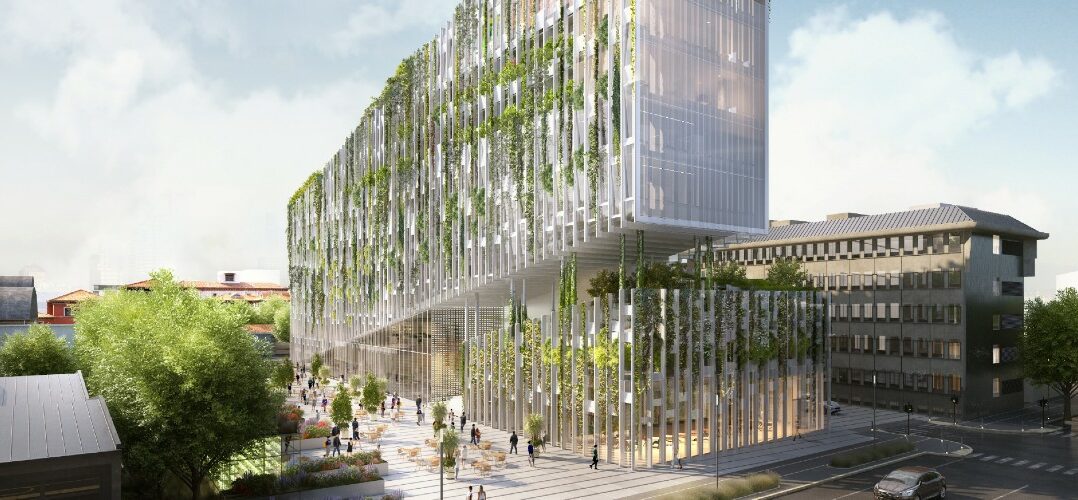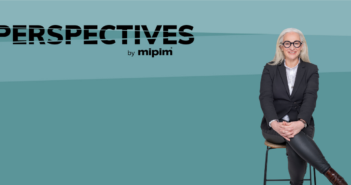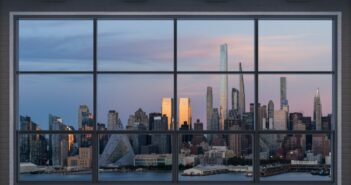“Never allow a good crisis go to waste. It’s an opportunity to do the things you once thought were impossible,” Rahm Emanuel, former mayor of Chicago, wrote earlier this year.
Emmanuel was referring to how the US can emerge stronger from the pandemic. The same applies to business, to real estate – and to how and where we work.
The coronavirus crisis has proved to be a social experiment in home working. In CBRE’s 2020 Global Occupier Sentiment Survey, 63 per cent of respondents said they had no remote working pre-Covid. Now this has fallen to just 10 per cent.
“If you go to the office, it should be for an additional function that your home cannot fulfil,” says Carlo Ratti, founder of design & innovation office Carlo Ratti Associati and director of MIT’s Senseable City Lab.
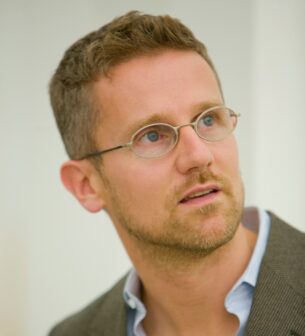
We have also seen the acceleration in the trend for flexible workspace – for spaces that foster innovation, collaboration and creativity; without forgetting the power of the serendipitous encounter.
This comes at a time when new skills are being required at work, including, in the words of Anthony Slumbers, co-founder of the Real Innovation Academy: design, imagination, inspiration, creation, empathy, intuition, innovation, abstract & critical thinking, collaboration, social intelligence and judgment.
Is this not the end of the office ?
In the 1960s, US futurist Melvin Webber predicted that the world would reach a “post-city age” and that “it might be possible to locate on a mountain top and to maintain intimate, real time, and realistic contact with business or other associates”, quotes Ratti.
The reality now is that we have not relocated to a mountain top and Webber’s prediction of the post-city age has still not happened. As humans, we are social beings.
The role of the city center headquarters likely won’t disappear, but employees will have more choice over where they work – CBRE
On a portfolio level, yes the office footprint may shrink; but, turning to CBRE’s 2020 Global Occupier Sentiment Survey, only 13 per cent of respondents believe that the importance of the physical office will decrease significantly in a post-Covid world.
City locations may serve as a more transient cultural base for employees in a broader real estate footprint – CBRE
“The role of the city center headquarters likely won’t disappear, but employees will have more choice over where they work,” says CBRE. “City locations may serve as a more transient cultural base for employees in a broader real estate footprint.”
That footprint could include working from home, working from a hotel (see Hotel sector: looking towards the horizon), (or the beach), or from suburban satellite locations near where employees live.
How we measure and quantify space is also likely to change. The “basis of space procurement and accounting” will shift from “area” and “headcount to “service level” and “quality of user experience” within the next three years, expect 44 per cent of respondents to the CBRE survey.
Embedding nature and comfort in the workplace
That quality of user experience in the workplace will be about embedding nature and comfort, says Ratti. This goes hand in hand with the concept of biophilia, first theorised by Edward O Wilson and defined by Carlo Ratti Associati as the “natural instinct of seeking balance with nature”.
A recent CRA project, VITAE, being developed by Covivio, is designed with biophilia in mind. VITAE is a 10,000m2 mixed-use building with a 200 meter-long vineyard that creates a publicly accessible footpath running from street level to the rooftop.
The array of functions seeks to create a harmony between nature and science, public and private life – Carlo Ratti, CRA/MIT Senseable City Lab
Located near the Fondazione Prada contemporary art museum in south Milan, VITAE will host a farm-to-table restaurant on the ground level, high-tech offices above, and a series of facilities for the leading molecular and oncology research centre IFOM, including terraced guest rooms for its international researchers, on the higher floors.
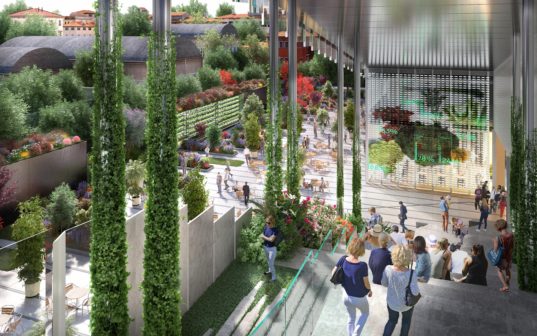
“The array of functions seeks to create a harmony between nature and science, public and private life,” says Ratti.
The project, which also includes a total of 5,000m2 of public space, was a winner of the Reinventing Cities competition organised by the C40 Cities Climate Leadership Group.
Using data to design better workspaces
“The office is a place to choreograph – a place to create more activity,” said Ratti on a MIPM Connect webinar on the future of the office. “With better data on occupancy, we can design a built environment that adapts to humans, rather than the inverse.”
The office is a place to choreograph – a place to create more activity – Ratti, CRA/MIT Senseable City Lab
Using digital tools, the MIT Senseable City Lab in the US mapped the physical location of MIT campus users and the email communication between them both before and after the Covid lockdown.
Weak ties are more likely to connect us with new ideas and perspectives – Ratti, MIT Senseable City Lab
The team found that ‘strong ties’ (between people who know each other well) got stronger after lockdown and ‘weak ties’ got weaker. “By bridging different social circles, ‘weak ties’ are more likely to connect us with new ideas and perspectives, challenging our preconceptions and fostering innovation and its diffusion,” writes Ratti.
The conclusion? The physical office space is still very important for those businesses seeking more serendipity, a stronger social network and increased creativity.
The workplace as a collection of connected physical & digital spaces
With user expectations and demands accelerating in “previously unimaginable ways”, architectural practice Gensler sees the need to “seamlessly fuse architecture and technology” to create “spatial experiences” that are higher in quality and value than they were before.
“Post-pandemic, it’s clear that the workplace will no longer be a single physical place, but a collection of connected physical and digital spaces that will serve as a trusted network for business continuity, social engagement, and continued professional growth,” writes Gensler’s global design director Jordan Goldstein and digital experience design leader David Kramer in Fusing Architecture and Technology to Reenter a New World.
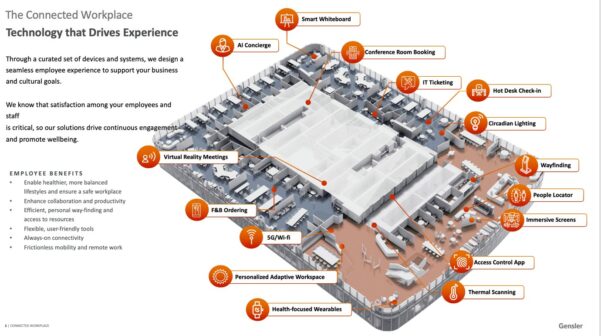
An opportunity to rethink the way we work
“The future of work is here; it is human centric, data driven, and dedicated to choice, trust, safety, health, wellbeing and experience,” says Ronen Journo, Senior Vice President, Enterprise & Workplace Strategy for WeWork. “Space will be consumed as and when and where it is required.”
The future of work is here; it is human centric, data driven, and dedicated to choice, trust, safety, health, wellbeing and experience – Ronen Journo, WeWork
Journo should know. He has spent the last few months talking with leaders from 68 companies (representing six million employees) in 14 industry round tables and over 40 playback learning sessions about the “social experiment” of running a business under lockdown.
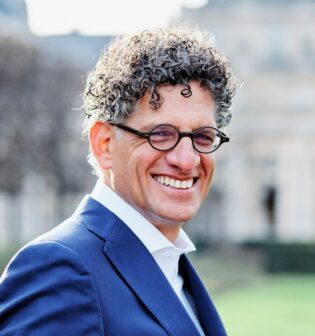
Ronan Journo of WeWork
He was sharing his feedback on the MIPIM Connect webinar, Buildings that take care of people. “If everything seems to be in balance, why would you go back to the old way of doing things?” he asked. “Boards are saying that this is a once in a lifetime opportunity to rethink the way we do work.”
Space will be consumed a sand when and where it is required – Journo, WeWork
Productivity has gone up in many sectors since lockdown, added Journo. However, not everything is about productivity.
“Building a business and social community will be important, as we will put value on the time that we spend physically together in that destination,” he explained.
“If people are going to be asked to commute to a destination, we will also put value on that commute time. »
The rise of hybrid workplaces
In the CBRE survey, a quarter of respondents said they were exploring suburban satellite strategies, with employees working closer to home.
In the US, for example, CBRE reports an uptick in interest in suburban office locations in north-eastern cities where public transport is good, although this is yet to be translated into transactions.
The likely outcome of this “optimisation” is a hybrid workforce network with the headquarter building itself becoming part of that network, says CBRE.
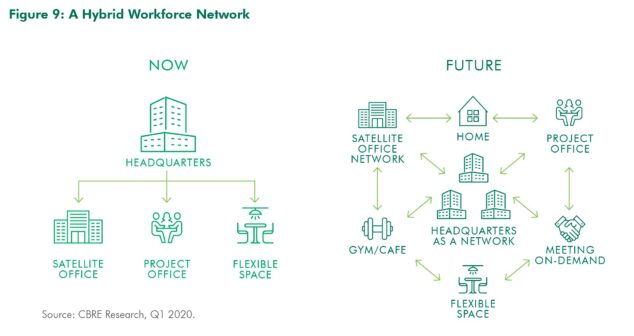
As we have learnt since the outbreak of pandemic, we are all connected and interconnected, globally and locally.
